|
|
|
|
|
|
|
|
|
From about 1869, the signal arms on the London, Brighton & South Coast Railway were painted red on the front but with a black stripe [2.19 & 2.20].
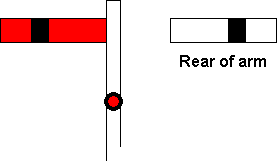 |
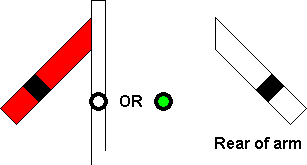 |
|
[2.19] Semaphore Signal ('on').
Area: LB&SCR Usage: High Status: Historical |
[2.20] Semaphore Signal ('off').
Area: LB&SCR Usage: High Status: Historical |
|---|
The LB&SCR's Outdoor Superintendent, W J Williams, had the idea of cutting a 'fishtail' notch into the ends of distant signal arms [2.21 & 2.22] so that drivers could distinguish them from stop signals, albeit during daylight hours only. Fishtailed arms were first introduced at Norwood Junction, in August 1872.
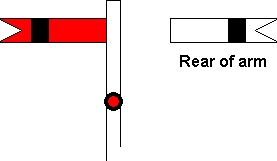 |
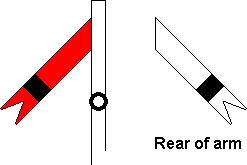 |
|
[2.21] Semaphore Distant Signal with Fishtailed Arm ('on').
Area: LB&SCR Usage: High Status: Historical |
[2.22] Semaphore Distant Signal with Fishtailed Arm ('off').
Area: LB&SCR Usage: High Status: Historical |
|---|
From 1876/1877, other railways began to follow the LB&SCR's example and provided fishtails in their distant signals [2.23 - 2.28]. In 1877, this important feature became a requirement of the Board of Trade.
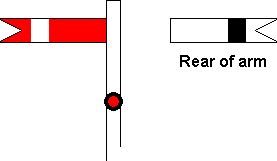 |
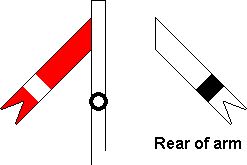 |
|
[2.23] Semaphore Distant Signal with Fishtailed Arm ('on').
Area: Various Usage: High Status: Historical |
[2.24] Semaphore Distant Signal with Fishtailed Arm ('off').
Area: Various Usage: High Status: Historical |
|---|---|
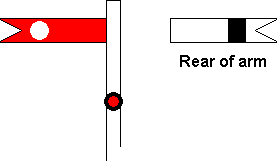 |
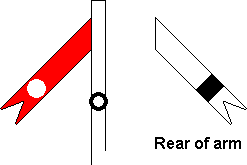 |
|
[2.25] Semaphore Distant Signal with Fishtailed Arm ('on').
Area: SER Usage: High Status: Historical |
[2.26] Semaphore Distant Signal with Fishtailed Arm ('off').
Area: SER Usage: High Status: Historical |
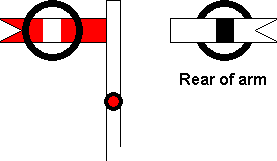 |
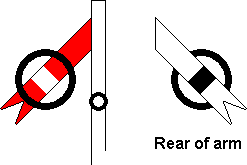 |
|
[2.27] Ringed Semaphore Distant Signal with Fishtailed Arm ('on').
Area: LNWR Usage: High Status: Historical |
[2.28] Ringed Semaphore Distant Signal with Fishtailed Arm ('off').
Area: LNWR Usage: High Status: Historical |
The Midland Railway's distant signals were notable for having a black band along the middle of the rear side of the arm [2.29 & 2.30]. Some distant signals on the Central Division of the North Eastern Railway had a black cross on the rear of the arm [2.31 & 2.32].
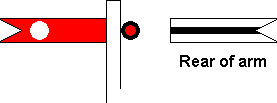 |
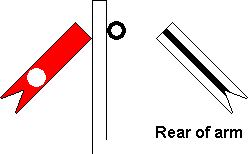 |
|
[2.29] Semaphore Distant Signal with Fishtailed Arm ('on').
Area: Mid.R Usage: High Status: Historical |
[2.30] Semaphore Distant Signal with Fishtailed Arm ('off').
Area: Mid.R Usage: High Status: Historical |
|---|---|
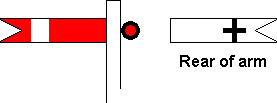 |
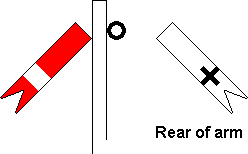 |
|
[2.31] Semaphore Distant Signal with Fishtailed Arm ('on').
Area: NER Usage: Unknown Status: Historical |
[2.32] Semaphore Distant Signal with Fishtailed Arm ('off').
Area: NER Usage: Unknown Status: Historical |
Another new requirement to come from the Board of Trade in 1877 stated that where stop and distant arms were placed together on the same post, the stop arm must be the higher of the two [2.33 - 2.35]. The Glasgow & South Western Railway had previously employed the opposite arrangement, placing the distant arm at the top of the post.
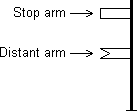 |
 |
 |
|
[2.33] Stop and Distant arms both 'on'. *
Area: All Areas Usage: High Status: Current |
[2.34] Stop arm 'off', Distant arm 'on'. *
Area: All Areas Usage: High Status: Current |
[2.35] Stop and Distant arms both 'off'. *
Area: All Areas Usage: High Status: Current |
|---|
| * Note: | The illustrations above serve only to show the positions of the signal arms, which are described elsewhere in this section. |
On 21 January 1876, a double collision occurred at Abbots Ripton on the Great Northern Railway as a consequence of semaphore arms being frozen inside their slotted posts, which prevented them from returning to the 'on' position. This prompted one of the GNR's signal fitters, Edward French, to design a new form of semaphore signal in which a centrally balanced arm operated outside of the post. While the 'on' indication was no different in appearance from that of previous semaphores, the arm in the 'off' position remained fully visible in an almost vertical position [2.36 & 2.37] and not obscured within the post. Another improvement was to show a green light at night when the arm was in the 'off' position, to avoid a white light, which might be seen as a result of a broken red lens, being mistaken for a 'clear' indication while the signal was at 'danger'. Known as 'somersault' signals, the new form of semaphore arm was first used by the GNR in 1877. These were apparently the first semaphore signals to give a positive 'clear' indication.
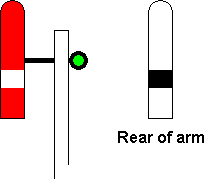 |
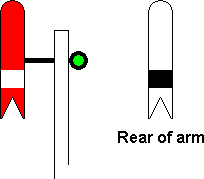 |
|
[2.36] 'Somersault' Stop Signal ('off').
Area: Predominantly GNR Usage: High Status: Historical |
[2.37] 'Somersault' Distant Signal ('off').
Area: Predominantly GNR Usage: High Status: Historical |
|---|
From 1877, the Great Northern Railway began to distinguish its signals applying to goods lines or slow lines by fitting rings to their arms [2.38 & 2.39]. In addition to being fitted with rings, the same signals were altered to show a purple light at night in the 'off' position [2.39].
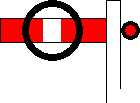 |
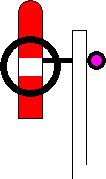 |
|
[2.38] Ringed 'Somersault' Stop Signal ('on').
Area: GNR Usage: High Status: Historical |
[2.39] Ringed 'Somersault' Stop Signal ('off').
Area: GNR Usage: High Status: Historical |
|---|
|
|
|